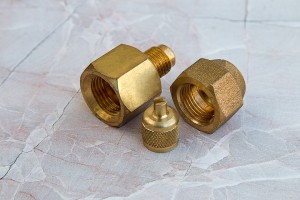 Identified by its characteristic dark-gold color, brass is a metal alloy consisting of copper and zinc. It’s often preferred over other metal alloys for its color, which is why doorknobs are often made of brass. However, brass is used in many other applications as well, such as bearings, gears, locks, valves, fittings, musical instruments and more.
Identified by its characteristic dark-gold color, brass is a metal alloy consisting of copper and zinc. It’s often preferred over other metal alloys for its color, which is why doorknobs are often made of brass. However, brass is used in many other applications as well, such as bearings, gears, locks, valves, fittings, musical instruments and more.
In addition to its decorative appearance, brass offers other benefits worth noting. It has a higher malleability than both bronze and zinc, for instance, allowing metal workers to easily alter its shape and physical composition. Brass also has a low melting point of 1,650 to 1,720 degrees Fahrenheit, further increasing the ease of which it is worked.
The properties of brass can also be changed with relative ease. This is done by changing the ratio of copper to zinc. Adding more copper and less zinc makes it harder, while adding more zinc and less copper makes it softer. Metal workers must pay close attention to the ratio of zinc to copper to ensure the preferred outcome for brass.
Soft brass isn’t necessarily bad. On the contrary, some workers prefer it because it’s easier to bend and alter. Soft brass, for instance, can be machined without the need for cutting fluid.
Some people assume that brass is a poor choice of metal for outdoor applications, believing it’s susceptible to rust. Like all metals, brass can rust when exposed to water and oxygen for a prolonged length of time. The oxygen triggers a process known as “oxidation” that ultimately results in rust. However, adding aluminum to brass gives it greater resistance to this phenomenon. Aluminum acts as a barrier of the brass, protecting the trace iron within from oxidation and subsequent corrosion.
Furthermore, brass is easily recycled. Statistics show that nearly 90% of all brass alloys are recycled. When recycled, brass is melted down for use in other applications.
Brass is also easy to clean and maintain. For most jobs, cleaning brass requires nothing more than a warm, damp washcloth. Whether it’s a doorknob or fitting, you can clean it by wiping down the brass surface with a washcloth. If the item which you are cleaning is particularly dirty, you can clean it using a diluted vinegar. Fill a spray bottle with 1 part water and 1 part vinegar, and use this solution to clean the brass. The acidic properties of vinegar will eat through dirt, while leaving your brass safe and protected.
